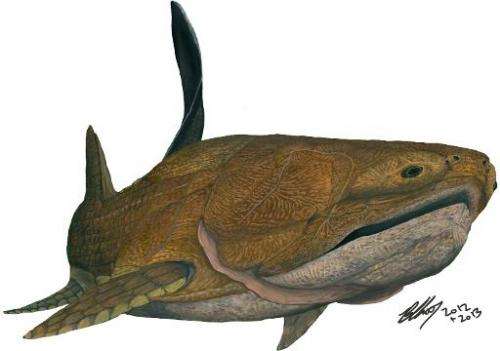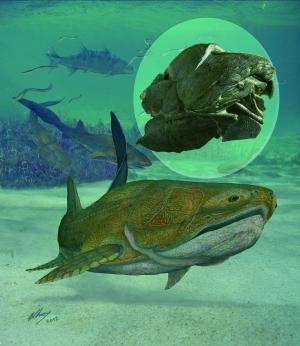Fish fossil yields jaw-dropping data on Man's past

The ancestor of all creatures with jaws and a backbone was not a sleek, shark-like beast but a toothless, armoured fish, said a study Wednesday that rewrites Man's evolutionary history.
Scientists said they had found a 419-million-year-old fish fossil in China which disproves the long-held theory that modern animals with bony skeletons (osteichthyans) evolved from a shark-like creature with a frame made of cartilage.
The osteichthyan group includes most living fish, humans and other land animals with limbs.
It had long been thought that modern-day cartilaginous fish like sharks and rays, which form a sister group to osteichthyans, most closely represent the original jawed ancestor that gave rise to the two animal types.
This meant that we osteichthyans would have evolved our bony frames from scratch while the group that includes sharks, rays and ratfish retained their ancestral cartilage skeletons.
But the new find of a primordial fish with a complex arrangement of small skull and jaw bones revealed a missing branch on the evolutionary tree and showed that a bony skeleton was in fact the prototype for all vertebrates, a research team wrote in the journal Nature.
"This astounding discovery does throw a spanner in the works of some long-held ideas about vertebrate evolution," said study co-author Brian Choo from the Institute of Vertebrate Palaeontology and Palaeoanthropology in Beijing.

"The implications are clear: ostheichthyans did not independently acquire their bony skeletons, they simply inherited them" from their ancestors—heavily-armoured fish known as placoderms that are accepted to be the most primitive members of the jawed vertebrate family.
"Osteichthyans didn't go through an unarmoured shark-like... stage during their early evolution only to reacquire their bone later on, they simply kept the plates directly from their... ancestors," said Choo.
This meant that sharks and rays, instead of being the archetypal vertebrates, shed the common ancestor's bony plates as they evolved, said the team.
The newly discovered creature, dubbed Entelognathus primordialis (meaning primordial complete jaw) was a type of placoderm that lived in the seas of China in the Late Silurian period from about 423 million to 416 million years ago.
The weird-looking animal, whose near-complete fossil was dug up near the southern Chinese town of Qujing, was about 20 centimetres (about eight inches) long, had a heavily armoured head and trunk and a scaly tail.
It had jaws but no teeth and tiny eyes set in large, bony goggles. It was not a direct ancestor of today's jawed vertebrates, but an extinct "close nephew" of our common forefather that shared many of its characteristics, according to Choo.

"I was completely blown away upon seeing this fossil for the first time, even more so as the full implications started to sink in," he told AFP.
"Every now and then you are confronted with jaw-dropping specimens like Lucy the Australopithecus (an extinct, upright-walking hominid) or the first batch of Chinese feathered dinosaur, unleashing a flood of new information that greatly clarifies our view of the distant past and often forces us to rethink what we thought we knew about evolution.
"A little fish called Entelognathus now joins the ranks of these exceptional fossil discoveries."
Commenting on the find, palaeontologists Matt Friedman and Martin Brazeau said the implications were "stunning".
"It will take time to fully digest the implications of such a remarkable fossil, but it is clear that a major reframing of our understanding of early gnathostome (jawed vertebrate) evolution is now in full swing," they wrote in Nature.
More information: Paper: dx.doi.org/10.1038/nature12617
Journal information: Nature
© 2013 AFP


















